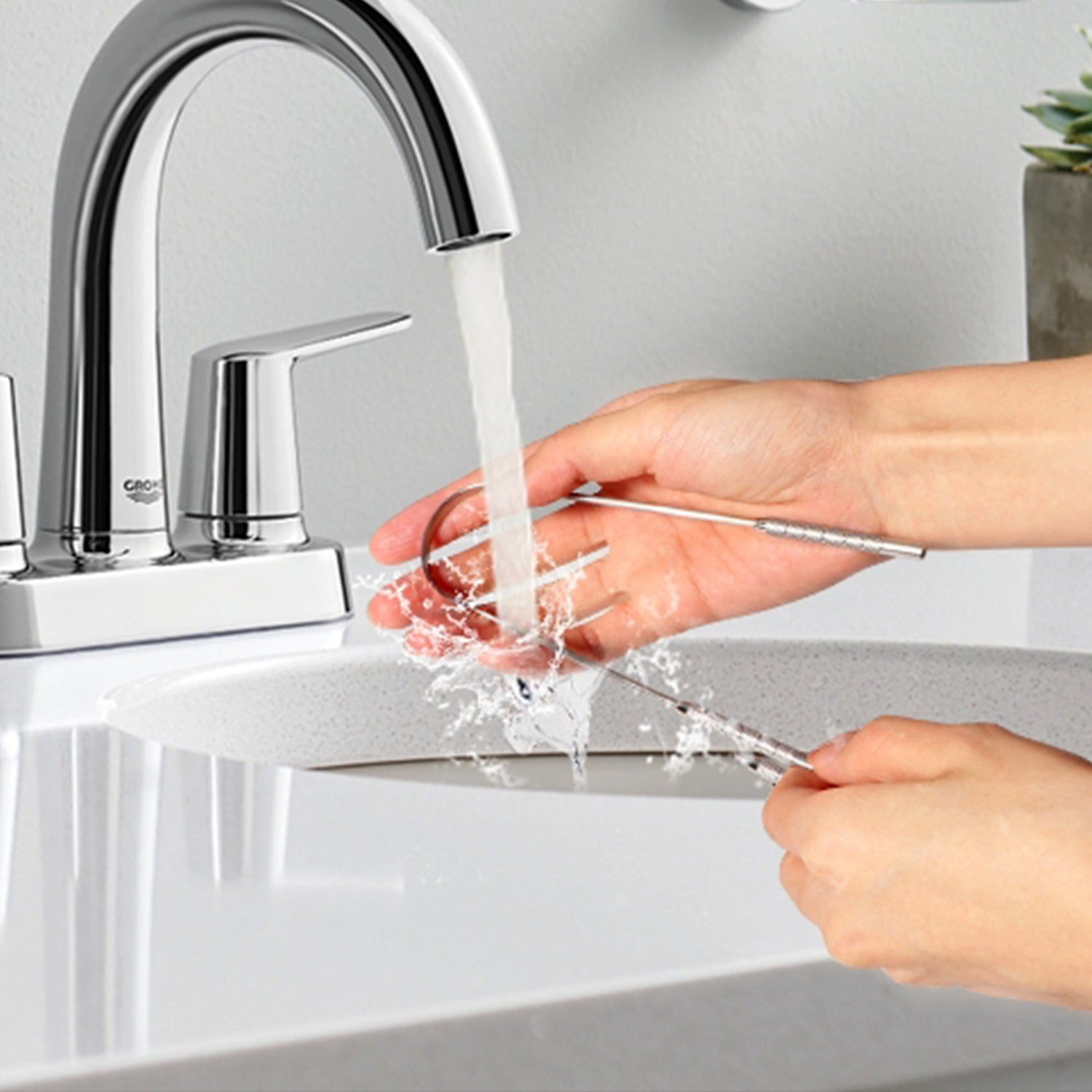Maintaining oral hygiene is more than just brushing and flossing. One of the lesser-known but highly effective tools for keeping your mouth clean is the tongue scraper. Specifically, a stainless steel tongue scraper can play a vital role in removing bacteria, food particles, and dead cells from the tongue’s surface. However, to ensure that your tongue scraper is doing its job efficiently, it’s essential to keep it clean. A well-maintained tongue scraper not only works better but also lasts longer, safeguarding your oral health.
In this guide, we’ll delve into why it’s important to clean your tongue scraper regularly and provide you with step-by-step instructions on how to do it effectively.
Why Cleaning Your Tongue Scraper is Crucial
Before diving into the cleaning process, it’s important to understand why this task is so vital. Your tongue is a breeding ground for bacteria, and each time you use your scraper, it collects a substantial amount of this bacteria along with other residues. If not properly cleaned, these harmful substances can build up on the scraper, reducing its effectiveness and potentially reintroducing bacteria into your mouth. By keeping your tongue scraper clean, you ensure that it remains a powerful tool in your oral hygiene routine.
-
Prevent Bacterial Growth:
Without regular cleaning, bacteria can multiply on the scraper, leading to bad odors and potentially harmful effects on your health. Regular cleaning prevents this bacterial build-up. -
Prolong the Life of Your Scraper:
Stainless steel is durable, but it can still degrade over time if not cared for properly. Regular cleaning prevents rust, discoloration, and wear, allowing your scraper to serve you well for years. -
Maintain Effective Oral Hygiene:
A clean scraper works better. When you regularly clean your scraper, it removes more bacteria from your tongue, contributing to better breath and overall oral health.
Step-by-Step Guide to Cleaning Your Stainless Steel Tongue Scraper
Cleaning a stainless steel tongue scraper is straightforward, but consistency is key. Let’s break down the process into easy-to-follow steps.

- Rinse After Each Use
The first step in keeping your tongue scraper clean is to rinse it immediately after each use. This simple action helps remove most of the debris and bacteria that accumulate on the scraper during use.
-
How to Do It:
Hold your tongue scraper under warm running water, ensuring that all the surfaces, including the edges, are rinsed thoroughly. Use your fingers to gently rub off any visible residue. -
Why It’s Important:
Rinsing right after use prevents the debris from drying and sticking to the scraper, making it easier to clean thoroughly later on.
- Clean with Soap and Water
While rinsing helps with immediate cleaning, you need to do a bit more to ensure that your tongue scraper is thoroughly clean. Using soap and water is an easy and effective way to do this.
-
How to Do It:
Apply a few drops of mild dish soap onto the scraper. Using a soft cloth, sponge, or even a toothbrush, gently scrub all surfaces of the scraper. Pay special attention to the edges and grooves, as these areas can harbor bacteria. -
Why It’s Important:
Soap helps break down any remaining oils or bacteria that water alone can’t remove, ensuring your scraper is genuinely clean and ready for its next use.
- Disinfect for Added Protection
While soap and water are usually sufficient for daily cleaning, it’s a good idea to disinfect your tongue scraper regularly. This is especially important if you’ve been sick or if you want to ensure that your scraper is as clean as possible.
-
How to Do It:
Prepare a disinfectant solution by mixing equal parts water and white vinegar in a small bowl. Soak your tongue scraper in this solution for 10-15 minutes. Alternatively, you can use a 1:1 mixture of water and hydrogen peroxide for an even stronger disinfectant effect. After soaking, rinse the scraper thoroughly with warm water to remove any lingering solution. -
Why It’s Important:
Disinfecting your scraper kills any remaining bacteria and helps to keep your scraper in top condition. It also helps remove any stubborn stains that may have developed over time.
- Boil for a Thorough Clean
For those who want to go the extra mile, boiling your tongue scraper is an excellent way to ensure that it’s thoroughly cleaned and free from any harmful microorganisms.
-
How to Do It:
Bring a pot of water to a boil and carefully place your tongue scraper into the boiling water. Let it boil for about 5 minutes. Afterward, remove the scraper with tongs and let it cool before handling. -
Why It’s Important:
Boiling water is a highly effective way to kill any remaining bacteria, germs, or viruses that might be lingering on your scraper. This method is especially useful if you haven’t cleaned your scraper in a while or if you want to ensure it’s as clean as possible.
- Dry Thoroughly
Drying your tongue scraper after cleaning is crucial. Stainless steel is resistant to rust, but it’s still a good idea to dry it thoroughly to prevent any potential moisture-related issues.
-
How to Do It:
After cleaning, use a clean towel to wipe down the scraper, making sure to dry all the surfaces, especially the edges. Alternatively, you can let it air dry completely on a clean surface. -
Why It’s Important:
Proper drying prevents water spots, rust, and bacterial growth. A dry scraper is less likely to harbor bacteria and will remain in good condition for longer.
- Store in a Clean, Dry Place
Once your tongue scraper is clean and dry, storing it correctly is the next step. Proper storage helps to keep your scraper clean between uses and extends its lifespan.
-
How to Do It:
Store your tongue scraper in a clean, dry place, preferably outside of the bathroom where moisture levels are lower. You can also keep it in a ventilated holder or a designated container to prevent it from coming into contact with other items. -
Why It’s Important:
Storing your scraper in a dry environment reduces the risk of rust and prevents bacteria from growing on its surface. It also ensures that your scraper is ready for use whenever you need it.
- Maintain a Regular Cleaning Routine
For the best results, make cleaning your tongue scraper a regular part of your oral hygiene routine. Regular cleaning ensures that your scraper remains effective and safe to use.
-
How to Do It:
Make it a habit to rinse your scraper after each use, clean it with soap and water regularly, and disinfect it at least once a week. Boil it occasionally for a deep clean, especially if you feel it needs extra care. -
Why It’s Important:
Consistency is key to maintaining both the cleanliness and effectiveness of your tongue scraper. A regular cleaning routine will help you get the most out of your scraper and contribute to better overall oral hygiene.
Additional Tips for Keeping Your Tongue Scraper in Top Shape
In addition to the steps outlined above, there are a few more tips that can help you maintain your tongue scraper and ensure that it remains a valuable part of your oral hygiene routine.
-
Replace Your Scraper When Needed:
Although stainless steel tongue scrapers are durable, they aren’t indestructible. Over time, the edges may become dull, or the scraper might show signs of wear. If you notice these issues, consider replacing your scraper to maintain optimal performance. -
Avoid Using Harsh Chemicals:
While it might be tempting to use strong cleaning agents to disinfect your scraper, these can actually damage the stainless steel. Stick to mild soaps, vinegar, or hydrogen peroxide for cleaning to keep your scraper in the best condition. -
Don’t Share Your Tongue Scraper:
Tongue scrapers, like toothbrushes, are personal hygiene tools and should not be shared. Sharing can transfer bacteria and other pathogens, which can be harmful. -
Be Mindful When Traveling:
If you travel frequently, consider investing in a travel case for your tongue scraper. This will protect it from damage and keep it clean while it’s in your luggage. -
Practice Consistency:
The more consistent you are with cleaning your scraper, the easier it will be to maintain. Regular cleaning prevents build-up and ensures that your scraper remains effective.
-
Replace Your Scraper When Needed:
Conclusion
Your stainless-steel tongue scraper is an essential tool in your oral hygiene routine, and like any tool, it requires proper care and maintenance to function at its best. By following the steps outlined in this guide, you can ensure that your tongue scraper remains clean, effective, and long-lasting.
Remember, a clean scraper not only works better but also contributes to a healthier mouth and fresher breath. By making these cleaning practices a regular part of your routine, you’ll enjoy the benefits of a well-maintained tongue scraper for years to come. So, take a few minutes each day to clean, disinfect, and store your scraper properly – your oral health will thank you!




Leave a comment
This site is protected by hCaptcha and the hCaptcha Privacy Policy and Terms of Service apply.